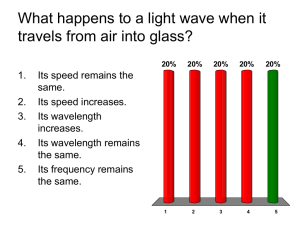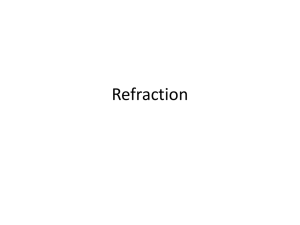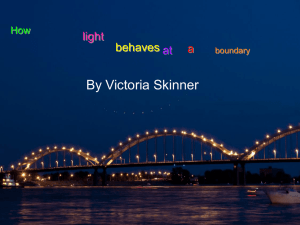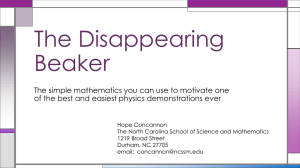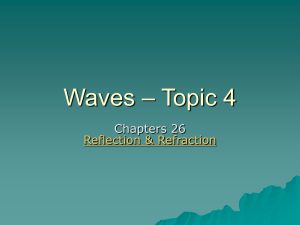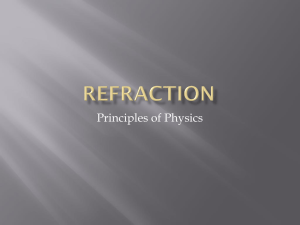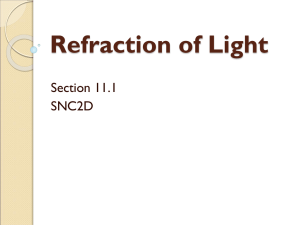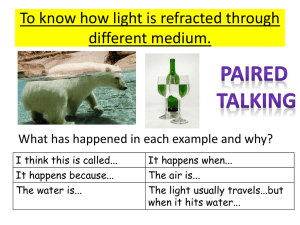Refraction
advertisement
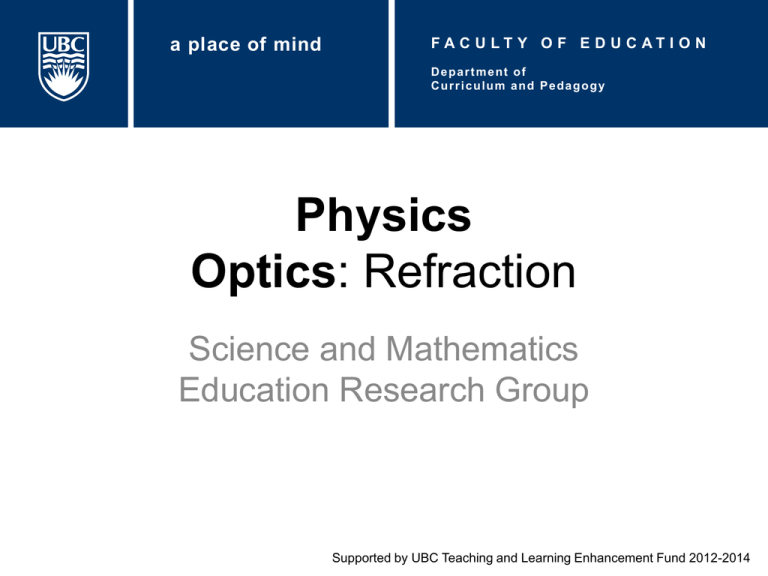
a place of mind FA C U LT Y O F E D U C AT I O N Department of Curriculum and Pedagogy Physics Optics: Refraction Science and Mathematics Education Research Group Supported by UBC Teaching and Learning Enhancement Fund 2012-2014 Refraction Refraction I What physical phenomenon is responsible for what you see in this photo? A. Reflection B. Refraction C. Magnification D. Reduction E. Projection Solution Answer: B Justification: Pencils do not bend in water. However, looking at this glass from the outside, the pencil appears to be bent. In order for us to see the pencil, it has to be illuminated by external light. The light that reflects of the bottom half of the pencil travels first through water and then through air. As light crosses the boundary between these two media (plural for medium) it bends. This phenomenon is called refraction. This refraction of light creates the appearance of a bent pencil as shown in the figure. Tip of image will form here, where lines intersect. Refraction II Consider this image of a pencil in a glass of water. Why does the pencil appear bent? A. Light reflecting off the pencil refracts as it travels from water to air B. Light reflecting off the pencil disperses as it travels from water to air C. The pencil loses structural integrity and bends. D. Light emitted by the pencil refracts as it travels from water to air. Solution Answer: A Justification: Pencils do not bend in water. However, looking at this glass from the outside, the pencil appears to be bent. In order for us to see the pencil, it has to be illuminated by external light – the pencil is not a light source and does not emit light. Dispersion of light occurs because the index of refraction of light depends on the colour (frequency) of the light. Think about how rainbows are created The light that reflects of the bottom half of the pencil travels first through water and then through air. As light crosses the boundary between these two media it bends (refracts). This refraction of light creates the appearance of a bent pencil as shown in the figure. Extend Your Learning: Video Title: The Science of Rainbows Fermat Principle Fermat’s principle: A light ray propagating between any two points always takes the path it can traverse in the least amount of time. Because light travels at different speeds in different media, when light travels across a boundary from one medium to another, the direction of travel may change. Least distance is not the same as least time unless the medium doesn’t change. Refraction III Refraction occurs because… A. Light travels at different speeds in different media B. Light obeys different laws in different media C. Light never travels along a straight line D. Light always follows the path of least distance Solution Answer: A Justification: Fermat’s principle states that light travels along the path of least time. Light also travels at different speeds in different media (materials), but always obeys the same laws. When light travels from one medium to another, the speed of light changes, and the path is adjusted to continue to follow the path of least time. Refraction IV The angle of refraction… A. Is always equal to the angle of incidence B. Is always greater than the angle of incidence C. Is always less than the angle of incidence D. May be greater than, less than, or equal to the angle of incidence Solution Answer: D Justification: Unlike the law of reflection, the angle of incidence and refraction are not always equal. This is because the light is not always travelling in the same material, and so the speed of light changes, and the path adjusts to follow the path of least time. The angle of refraction can be greater than, less than, or equal to the angle of incidence. Refraction V The angle of refraction depends on… A. The index of refraction of the incident medium B. The index of refraction of the refracting medium C. The indices of refraction of both media Solution Answer: C Justification: As we discussed in the previous question, the angle of refraction can be greater than, less than, or equal to the angle of incidence. This is because the light is not always travelling in the same material, and the speed of light changes. Light always follows the path of least time, not distance, so when the speed changes the direction must also change. Depending on the refractive indices of the media on each side of a boundary, the angle of refraction can be greater than, less than, or equal to the angle of incidence. Refraction VI A ray of light travels from air into a block of glass. Identify the angle of refraction. air B A C D glass The normal is represented by a dashed line. Solution Answer: D Justification: Think about the law of reflection, and how the incident and reflected angles are measured. In a situation involving refraction, the incident and refracted angles are measured in the same way as a situation involving reflection – between the normal and the ray. In this situation, B is the angle of incidence (measured between the normal and the incident ray), and D is the angle of refraction (measured between the normal and the refracted ray). air B D glass Refraction VII A ray of light travels from air towards glass at an angle (red). At the interface, the ray … A A. Is totally reflected B. Is bent away from the normal C. Does not bend air glass B D. Is bent toward the normal E. Bends across the normal E D C Solution Answer: D Justification: Light travels more slowly in glass than it does in air. As a result, the light will bend towards the normal when it crosses the boundary between the two materials. Think about driving a car from pavement to gravel at an angle. When the first wheel hits the gravel, it will move slower than the others still on the pavement. Because the outside wheels are turning faster, the car will turn toward the first wheel, and the path bends toward the normal. Extend Your Learning: Activity The light ray: A group of students forms two straight lines (standing shoulder to shoulder).Each pair connects themselves using meter sticks. The media: A strip of masking tape divides the room into two media. In one of the media (on one side of the tape), students walk at a normal pace. In the other media (or on the other side of the tape), students walk very slowly using baby steps. Refraction: The group of students walk forward together in a straight line towards the diagonal strip of masking tape. The students maintain the line as they approach the masking tape. When an individual student reaches the tape, that student abruptly changes the pace of her/his walk. The group of students continues walking until all students in the line have entered into the second medium. Refraction VIII A light ray travels from medium A into medium B as shown. This means that: A. Light travels faster in B than in A B. Light travels faster in A than in B C. A is less optically dense than B D. B has a higher index of refraction than A E. All of the above Medium A Medium B Solution Answer: A Justification: The faster light travels in a given medium, the further the ray bends away from the normal line at the boundary. The angle of refraction in B is larger than the angle of incidence in A. This is because light is travelling faster in medium B. The speed of light in a medium is related to its optical density, and thus its index of refraction. The more optically dense a medium, the slower the light travels, and the larger the index of refraction. Because light travels more slowly in A, we know that A is more optically dense than B, and thus has a higher index of refraction. Think about the example of the car. What happens to the wheels when the car travels, at an angle, from gravel to pavement? Refraction IX water Light travels through water into air. The angle of refraction will be: air C A. Less than the angle of incidence B. Equal to the angle of incidence C. Greater than the angle of incidence A B Solution Answer: C Justification: When light travels from a medium with a high refractive index to one with a low refractive index, light bends away from the normal. When light travels from a medium with a low refractive index to one with a high refractive index, light will bend towards the normal. When light travels in the same medium, the speed of light does not change, no refraction occurs, and the angle of incidence and refraction are equal. Water is more refractive than air, so the light will bend away from the normal. Refraction X Light travels from air, through a glass block, and exits into air. The angle of refraction of the ray as it exits the block is A. Less than angle of incidence at entrance point B. Less than angle of incidence at exit point C. Equal to angle of incidence at entrance point D. Greater than angle of incidence at entrance point E. Not enough information Solution Answer: C Justification: When light travels from material A to B, light bends according to Snell’s Law. nA sin A nB sin B When light travels back across the boundary, the light bends (again) according to Snell’s Law. nB sin B nA sin A These equations are identical, implying that light behaves in an equal, but opposite, manner when it travels from A to B, and then B to A. The angle of incidence entering the block is equal to the angle of refraction leaving the block. Refraction XI A light ray travels from a given medium into three different media at the same angle of incidence. Medium A Rank the media's indices of refraction from greatest to least. A. nA = nB = nC Medium B B. nB > nC > nA C. nA > nC > nB D. nA > nB > nC E. nC > nA > nB Medium C Solution Answer: C Justification: To determine the relative refractive indices of medium A, medium B, and medium C, we have to look at the angle of refraction in each. In each situation, the light is incident at the same angle, from the same medium. This means we can directly compare each situation. Mathematically, since the initial medium and the angle of incidence are the same for all three media: ni sin i constant nr sin r Snell’s Law So as θR decreases, sinθR decreases, and nR must increase to maintain the constant ratio of Snell’s Law. The smaller the angle of refraction, the larger that medium's refractive index. Remember: θR < 90° Solution is continued on the next slide Solution Cont’d Medium A has the smallest angle of refraction and the largest index of refraction. Medium B has the largest angle of refraction and the smallest index of refraction. Medium C falls in the middle. Medium A Medium B Medium C Refraction XII A light ray travels through a vacuum and into a mystery medium. Which of the following diagrams could accurately represent a possible scenario for this system? Vacuum I Medium Vacuum A. Case I Medium II B. Case II C. Case III D. Cases I and II E. Cases I and III Vacuum Medium III Solution Answer: E Justification: The refractive index of a vacuum is 1. Light travels slower in every other medium, so every other medium must have an index of refraction greater than 1. When light travels from one medium to a medium with a larger index of refraction, the light ray bends toward the normal. Case I passes this test, case II does not, and case III causes the light to travel straight through with no “bending". Because the light does not bend as it travels into the mystery medium in Case III, we know that in that case, the mystery medium must be a vacuum. Case II shows a light ray bending away from the normal. This would mean that light travels faster in the mystery medium than it does in a vacuum. This is not possible, thus case II will never happen. Snell’s Law We know that light bends when it travels from one medium into another. But how much does it bend? Snell’s Law tells us how the incident and refracted rays are related, using the refractive indices of the two media. ni sin i nr sin r On the left hand side is the incident material. The refracting material is on the right. Extend Your Learning: Video Title: Snell’s Law Song Extend Your Learning: Video Title: Invisible Glass – How to make an object disappear Refraction XIII A light ray travels from air, into a glass block, and out the other side. In the first experiment, the block is made of flint glass (n = 1.66). In the second experiment, the block is made of crown glass (n = 1.5). Lateral displacement of light traveling through the flint glass block is: A. Less than the crown glass block B. Greater than the crown glass block C. Equal to the crown glass block Lateral Displacement Solution Answer: B Justification: The more refractive a material is, the more the refracted ray will bend towards the normal. Flint glass is more refractive than crown glass, so the refracted ray will bend more towards the normal in the flint glass than the crown glass. crown Bending more towards the normal means the ray is bending further from the original path of the light ray. When the ray refracts out of the block, the refracted ray will be parallel to the original, incident ray. Lateral displacement is the distance between these two rays. flint Refraction XIV A ray of light passes through a wedge of glass (ng = 1.5) as shown. The wedge is surrounded by air (na = 1). In which approximate direction is the ray travelling after leaving the wedge? Air Glass Air A B C Position of ray along exit edge is not accurate. Solution Answer: A Justification: When the light ray enters the wedge, it is refracted towards the normal because glass is more dense than air. It is travelling upwards, relative to the horizontal. Upon existing the second face, the light ray bends away from the normal as air is less dense than glass. This causes the light ray to point further up, away from the horizontal. Air Glass What if the block were made of air, and the light was travelling from glass to air and back? Would the direction of the refracted light be different? Air Refraction XV An observer is standing on a bridge, looking straight down into a pond full of gold fish. The goldfish appear to be A. Further away than they really are B. As far away as they really are C. Closer than they really are Solution Answer: B Justification: The observer is looking straight down into the pond, perpendicular to the surface of the water. Light does not refract when the angle of incidence is 90°, so looking in to the water is like looking through a window – the object is at its real distance. The goldfish appear to be as far from the surface as they really are. Refraction XVI An observer is standing on the side of a pond, looking out and down at the gold fish. The gold fish appears to be A. Swimming deeper in the pond B. Swimming at their actual depth C. Swimming closer to the surface Solution Answer: C Justification: When light travels from the goldfish to the eye of the observer, the light must cross the boundary between water and air. As the light exits the pond, it bends away from the normal. The observer sees the fish along this refracted line, which is above the position of the real fish. The same phenomenon is seen when a pencil is placed in a glass of water. Refraction XVII Light travels from air into a semicircular block. The incident light ray is pointed directly at the centre of the flat edge. Why is the light not refracted upon entering the block? air A. The law of refraction only applies for straight boundaries B. The radius of the block is perpendicular to the surface at all points glass C. The light doesn’t refract when it travels from air to glass D. The light doesn’t refract when it travels from glass to air E. It is refracted, but the angle is so small that we do not see it Solution Answer: B Justification: The glass block is a semicircle. At all points along the edge of a circle, the radius is perpendicular to the edge. Because the light ray travels along the radius, it is perpendicular to the surface at the point of contact. When light is incident on a boundary at 0 degrees (perpendicular to the surface – remember that angle of incidence is measured from the normal), no refraction occurs. ni sin i nr sin r We can test this mathematically 1.003sin 0o 1.5sin r using Snell's Law: 1.003 0 sin r 1 .5 r 0o Extend Your Learning: Video Title: Total Internal Reflection
